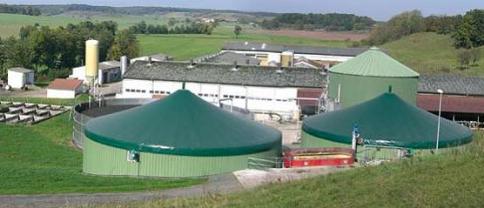Biogas: more profit from heat and cooling power

EuroTier 2008, held in Hanover, Germany, last November, did not only feature a lot of innovations in animal husbandry. Several halls were occupied by BioEnergy Europe, where the latest developments on biogas in agriculture could be learnt. An important show, since growing numbers of European pork producers are moving into the renewable energy market.
Biogas production on pig farms throughout Europe is beginning to take a new direction. Most manure-fed fermenters have so far concentrated on fuelling generators for electricity production. Countries such as Germany however, are guaranteeing a useful extra profit for farmers through schemes to encourage utilisation of the heat produced by the generators. New legislation starting 2009 offers smaller farmers incentives to start biogas production – and the fermenter sector is responding with a range of new compact reactors.
“But this route is only using 35 to 40% of the available energy from biogas production,” explains Gerd-Dieter Krieger, speaking at BioEnergy Europe, an exhibition highlighting agriculture-based power production and part of the world’s largest livestock event EuroTier 2008 in Hanover, Germany.
“Most of the remaining energy is heat that is produced during the generation process. Some 10 to 20% of this heat can be recycled right away to aid fermentation for biogas production. But there’s a tremendous potential for selling more of this heat and therefore helping profits and increasing the efficiency of the process – but also cutting back on fossil fuel use and associated production of climate damaging gases.”
Gerd-Dieter Krieger is deputy managing director of VDMA (German Engineering Federation) Power Systems, the organisation that joins forces with the German Agricultural Society (DLG) to stage the Bioenergy Europe exhibition within EuroTier.
“For farmers, and this includes a large number of pig producers, biogas production is already bringing in an increasing proportion of gross income,” he adds. “And there’s room for tremendous expansion still.” Among the 400 exhibitors taking part in Bioenergy Europe were many presenting ways of moving biogas or the resultant energy from the point of production on-farm to where it can be used most efficiently.
“Naturally, the most straightforward approach is generating electricity via gas engines and selling this direct to the network,” says Krieger. “But this neglects the available heat and there are other possibilities.”
* Farm plants are available for processing biogas to natural gas standard so that it can be fed into the national natural gas pipeline system for distribution. (This is quite an investment, though. Production of at least 1,000 m3 gas/hour is recommended before starting along this route.)
* On-farm utilisation could be increased. Farmers are already using some of the heat energy for warming their own pig housing and drying grain, for example.
* Some are even starting new enterprises on their farmland where more heat can be directly used. Greenhouse production is a good example of this.
* There’s also the possibility of starting a so-called microgas network. Here, excess gas is compressed and piped to nearby communities for power and heat production on-the-spot.
* But why should it always be heat production? A heat exchanger can turn this energy to cold and this energy is just as marketable for cooling milk, for air conditioning in buildings and for keeping interior temperatures down in pig buildings during summer.
Microgas
The German company Agrogen has already supplied three livestock farming units with a system developed to compress biogas and send it in small-diameter plastic (PE) pipelines to sites where it can be converted into power, heat and cold for on-the-spot use.
Jann Uphoff is the young engineer behind the Agrogen development. “Collecting heat from biogas production on the farm and piping to another location for use with a swimming pool, school buildings or village central heating system, is not too efficient,” he warns. “For every kilometre travelled there’s a certain amount of heat loss involved. “But if the gas is compressed and piped to the location of use and converted to energy on the spot, there is little or no loss in transport.”
A compact unit is supplied by Agrogen that cools the biogas, dewaters it and filters out sulphur before compressing for transport of up to 5.5 km. “This is the efficiency limit with the current technology,” says Uphoff. “But with all the biogas-producing farms we have looked at, there have been potential customers for the heat within a radius of 4 km in 80% of the cases.”
An Agrogen microgas unit capable of treating 200 m3 of biogas per hour costs around €45,000. The plastic pipeline used is usually 100 or 150 mm diameter and should be buried at about 1.5 m down where the earth temperature in southern Germany is fairly constant at 8°C.
Uphoff adds that there is another incentive under German regulations for piping gas to a electricity and heat generating plant at point of use: “The subsidy available for bioenergy production can be claimed for the on-farm plant and again for the point-of-use plant.”
Manure biogas heats hospice
One of the farm biogas plants adopting the microgas approach is at Isny in Bavaria and here gas is transported through plastic PE pipeline for a distance of 3.7 km where it powers a generator producing 330 kW electricity and 390 kW heat for old people’s accommodation and a hospice. In the German state of Saxony another farm is currently fitting a microgas transport system supplying a smaller community-based power station.
But what about selling cooling power from pig manure biogas?
Berndt Hebenstreit is marketing manager with the energy plant builder EAW-Westenfeld from Thuringia in Germany and he sells a biogas system that not only heats pig housing in winter but also keeps them cool in summer. For instance, heat exchangers fitted to the pig feeding housing at Norbert Wirsching’s Rieth farm prove effective at both – and summer cooling brings a bonus in feeding pig performance on his 750-place unit. The increase is worth an estimated €4.45 per slaughter pig, he calculates, see Table 1. The Rieth farm biogas plant produces 85 kW electricity and 176 kW heat with about 60 kW of heat recycled for the fermenting process and the remainder used for heating and cooling the pig production enterprise whilst also producing hot water for the farm’s dairy as well as cooling milk in the bulk tank.
In 2005 a comparison was made between compartments in the feeding pig housing that were cooled with biogas in summer and others with conventional ventilation. Pigs in the cooled compartments were not only healthier; they gained liveweight 8% faster.
A new German-language book* on the opportunities for on-farm and other decentralised energy production in Europe was launched to coincide with the BioEnergy Europe exhibition and the experts writing in this estimate that European bioenergy production will increase by as much as nine times between 2007 and 2030 to a production of some 728 Terawatt hours (TWh) of which Germany as world leader in this sector is expected to produce around 170 TWh. “This means farming has tremendous opportunities in decentral bioenergy production in the coming decades,” emphasises Krieger.
* “Bioenergie und dezentrale Energieversorgung. Chancen in Deutschland und Europa”. Published by DLG, VDMA and business consultancy A.T. Kearney.
Source: Pig Progress Volume 25 nr 2











